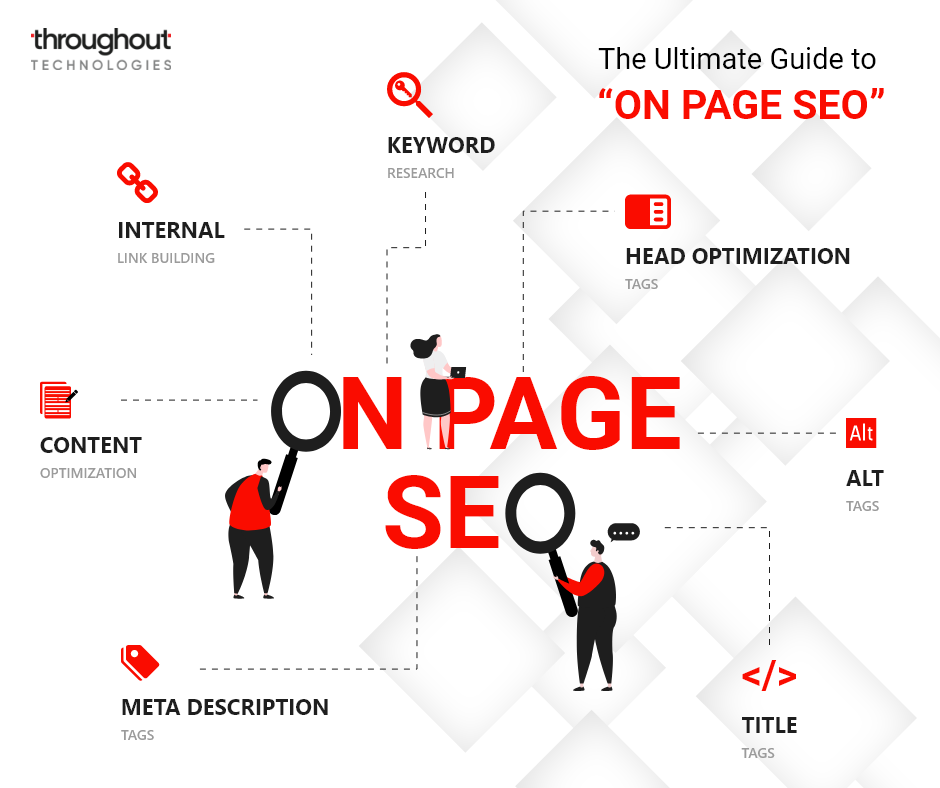Blog
Dec 13, 2022
The Ultimate Guide to “On page SEO”

As discussed on "How to become a SEO expert" blog, We got to know that Search engine optimization has 3 main buckets to master
One of this is On page SEO.
Looking for on-page SEO activities to boost your site’s rankings in search results? Check out on-page SEO techniques below:
1. On Page SEO
On-page SEO is the practice of optimizing web pages to help improve rankings and attract more organic traffic from search engines. This includes head and body optimization. It helps your site be optimized for both human eyes and search engine bots.
Every part of on-page SEO is completely up to you; that's why it's critical that you do it correctly. Now, let's discuss the elements of on-page SEO.
Head optimization
Body Optimization
Head Optimization:
Head optimization refers to changes under heading tags and head section of HTML, having various aspects:
Meta Tags:
Meta tags are snippets of text that describe a page’s content; the meta tags don’t appear on the page itself, but only in the page’s source code. Meta tags are essentially little content descriptors that help tell search engines what a web page is all about.
Meta Tags include:
Title tag:
This is the tag you see on the Search engine page, and at the top of the browser icon search engine shows this text as the title of the web page.
Your website page titles (also known as title tags) are one of the most important SEO elements.
Title Tag Must contain:
1. The character length is between 60 to 70 characters.
2. Include your entire keyword or keyword phrase.
3. Include your brand in the title, for example, “Digital transformation & IT solution- Throughout Technology”.
Meta description:
This brief description of the page that shows on the search engine result page while searching anything on the search engine page.
Here's what makes for a good meta description:
1. Keep it under 160-170 characters.
2. Include your entire keyword or keyword phrase.
3. Avoid alphanumeric characters like —, &, or +.
Canonical tags:
We all know google crawl all the pages on the website. In order to avoid some shot of confusion if there are two duplicate pages on the website then we need to specify to Google that there is one duplicate page and google needs to ignore that one and that can be done with the help of canonical tags.
Social media tag:
This tag is used for social media posts, in this tag we specify google
what content needs to be displayed on social media while sharing our website URL on any social media platform.
Body Optimization:
Body optimization refers to changes under body section of HTML, having various aspects:
Image optimization:
Image optimization consists of putting a keyword on the image name or we can say naming the image for SEO optimization.
Alt Tag:
The alt tag is to be mentioned in the body section of HTML to name the image with the keyword.
Points to be kept in mind to make a good Alt tag:
Make it descriptive and specific.
Make it contextually relevant to the broader page content.
Keep it shorter than 125 characters.
Include keyword phrases.
Image compression:
Image compression is an important point for image optimization. Checking the image quality, and size as per the user experience and user interface. Image compression also helps in reducing the load time of the website.
2. Content Optimization
Content is the most critical part of every website.
Whether it is a Blog or a website content should be optimized in such a way that will attract readers' attention, be understandable to search engines, and rank the content.
Here, The main points to be noted for content optimization:
Use your keywords in headings and paragraphs.
Breaking your content into skimmable headings.
Complement your content with helpful images.
Ensuring your content uses correct spelling and grammar.
Make your content trustworthy and authoritative.
Content optimization includes the use of keywords such as general keywords, Specific keywords, LSI, or long tell Keywords. On a single webpage, there must be at least 3- 5% of keywords.
3. Heading optimization:
The heading is the most important part of a website to rank, optimization of the heading is almost important this includes:
Heading must be simple and understandable.
Must include keywords.
4. Internal linking:
Internal links help market your blog posts as readers read your blog posts.
When someone is done reading your content you have to give him or her the next step. If you link to 4 or 5 previous blog posts you give the reader something to do next and it benefits you.
They continue to read your content. They stay on your site. You continue to build that trust and relationship.
Again, blog readers appreciate internal links and because readers show a preference towards internal linking, search engines do as well.
Internal linking gives search engines an indication of relevant content on your blog. By linking from an authoritative post on your blog to another relevant post you indicate that both posts are important.
Internal links can also increase traffic and time on site, which are two additional indicators search engines use to check the relevancy and authority of your blog.
5. Url optimization:
Url is also important factor for ranking at search engine optimization.
6. Blog Consistency
Blogging must be done consistently from time to time. New pages need to be added on the website related to the blog. Blogging catches readers' attention and generate traffic to the website.
Readers should have curiosity after reading the blog that what comes next.
Conclusion
After seeing all these on-page SEO activities, you’ve got a big to-do list ahead of you.
On Page SEO is the first foremost important aspect of Search engine optimization, keep the above points in mind and optimize your website to get rank high on SERP.